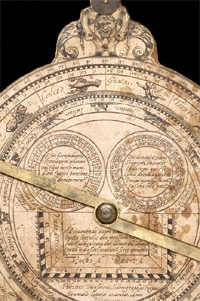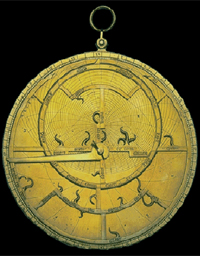 The astrolabe is a very ancient
astronomical computer for solving
problems relating to time and the
position of the Sun and stars in the
sky. The astrolabe is a very ancient
astronomical computer for solving
problems relating to time and the
position of the Sun and stars in the
sky.Evidence suggests that the history of the astrolabe begins more
than two thousand years ago. The
principles behind the astrolabe projection
were almost certainly known before 150 B.C.,
but the first known astrolabe is
believed to have been developed in
Alexandria about 160 B.C. by a Greek man
named Hipparchus. A
marriage of the planisphere and dioptra,
the astrolabe was effectively an analog
calculator capable of working out
several different kinds of problems in
spherical astronomy. Theon of Alexandria
wrote a detailed treatise on the
astrolabe, and Lewis (2001) argues that
Ptolemy used an astrolabe to make the
astronomical observations recorded in
the Tetrabiblos.Since that first
model history has recorded many
variations of astrolabes, including a
traditional design for use on land, the
Mariner's Astrolabe and the Universal
Astrolabe, just to name a few. By far the most popular type
is the planispheric astrolabe, on which
the celestial sphere is projected onto
the plane of the equator.
There is often
some confusion between the traditional
astrolabe and the mariner's astrolabe.
While the traditional astrolabe could be
useful for determining latitude on land,
it is an awkward instrument for use on
the heaving deck of a ship or in wind.
The mariner's astrolabe was developed to
address these issues by simplifying the
devices functionality and compacting
it's design.Astrolabes are used to show how the sky
looks at a specific place at a given
time. This is done by drawing the sky on
the face of the astrolabe and marking it
so positions in the sky are easy to
find. To use an astrolabe, you adjust
the moveable components to a specific
date and time. Once set, the entire sky,
both visible and invisible, is
represented on the face of the
instrument. This allows a great many
astronomical problems to be solved in a
very visual way.
The astrolabe quickly became the
dominant historical astronomical
instrument used by classical
astronomers, navigators, and
astrologers. Its many uses included
locating and predicting the positions of
the Sun, Moon, planets and stars;
determining local time given local
latitude and vice-versa; surveying; and
triangulation.
 Brass
astrolabes were developed in the
medieval Islamic world, chiefly as an
aid to navigation and as a way of
finding the qibla, the direction of
Mecca. The first person credited with
building the astrolabe in the Islamic
world is reportedly the 8th century
Persian mathematician al-Fazari. Brass
astrolabes were developed in the
medieval Islamic world, chiefly as an
aid to navigation and as a way of
finding the qibla, the direction of
Mecca. The first person credited with
building the astrolabe in the Islamic
world is reportedly the 8th century
Persian mathematician al-Fazari.
The
mathematical background was established
by the Arab astronomer al-Battani in his
treatise Kitab az-Zij (ca. 920 AD),
which was translated into Latin by Plato
Tiburtinus (De Motu Stellarum). The
earliest surviving astrolabe is dated AH
315 (927/8 AD). In the Islamic world,
astrolabes were used to find the times
of sunrise and the rising of fixed
stars, to help schedule morning prayers
(salat). In the 10th century, al-Sufi
first described over 1,000 different
uses of an astrolabe, in areas as
diverse as astronomy, astrology,
horoscopes, navigation, surveying,
timekeeping, prayer, Salah, Qibla, etc.
 Arzachel
(al-Zarqali) of al-Andalus constructed
the first universal astrolabe instrument
which, unlike its predecessors, did not
depend on the latitude of the observer,
and could be used from anywhere on the
Earth. This instrument became known in
Europe as the "Saphaea". The astrolabe
was introduced to other parts of Europe
via Al-Andalus in the 11th century.
Early Christian recipients of Arab
astronomy included Gerbert of Aurillac
and Hermannus Contractus. The first
geared mechanical astrolabe was later
developed by Abi Bakr of Isfahan in
1235. Arzachel
(al-Zarqali) of al-Andalus constructed
the first universal astrolabe instrument
which, unlike its predecessors, did not
depend on the latitude of the observer,
and could be used from anywhere on the
Earth. This instrument became known in
Europe as the "Saphaea". The astrolabe
was introduced to other parts of Europe
via Al-Andalus in the 11th century.
Early Christian recipients of Arab
astronomy included Gerbert of Aurillac
and Hermannus Contractus. The first
geared mechanical astrolabe was later
developed by Abi Bakr of Isfahan in
1235.
As testament to the astrolabe's
capabilities, mathematicians throughout
the ages continued to publish work after
work on new applications for the device. The English author
Geoffrey Chaucer (ca. 1343–1400)
compiled a treatise on the astrolabe for
his son, mainly based on Messahalla. The
same source was translated by the French
astronomer and astrologer Pelerin de
Prusse and others.
The first printed
book on the subject of the astrolabe was Composition
and Use of Astrolabe by Cristannus de
Prachaticz, also using Messahalla, but
relatively original. In 1370, the
first Indian treatise on the astrolabe
was written by the Jain astronomer
Mahendra Suri and in the
16th century, Johannes Stöffler
published Elucidatio fabricae ususque
astrolabii, a manual of the construction
and use of the astrolabe.
 The first known
European metal astrolabe was developed
in the 15th century by Rabbi Abraham
Zacuto in Lisbon. The first known
European metal astrolabe was developed
in the 15th century by Rabbi Abraham
Zacuto in Lisbon.
In the 15th century,
the French instrument-maker Jean Fusoris
(ca. 1365–1436) also started selling
astrolabes in his shop in Paris, along
with portable sundials and other popular
scientific gadgets of the day
 Four
identical 16th century astrolabes made
by Georg Hartmann provide some of the
earliest evidence for batch production
by division of labor. Four
identical 16th century astrolabes made
by Georg Hartmann provide some of the
earliest evidence for batch production
by division of labor.
Astrolabes are
still appreciated today for their unique
capabilities, their elegant beauty, and their value for
astronomy education. |

